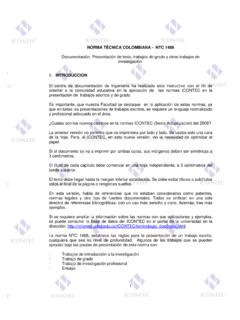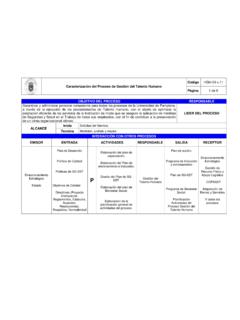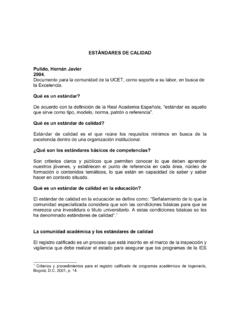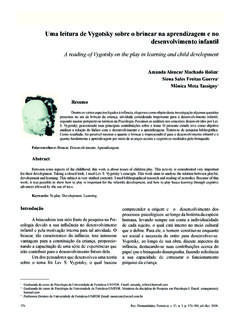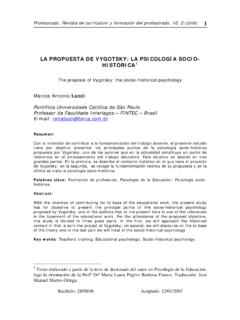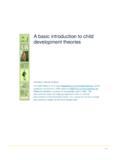Transcription of Vygotsky's theory in the classroom: Introduction
1 European Journal of Psychology of Education2004. Vol. XIX. n'I. 3-7 's theory in the classroom : IntroductionAlex KozulinInternational Center for the Enhancement of Learning Potential, IsraelThere seems to be a certain mystery in the current popularity of Vygotsky's ideas. Whydoes a theory developed in Moscow a few years after the Russian Revolution capture theimagination of European and American educators at the beginning of the 21 st century?One possible explanation of this puzzling phenomenon is that Vygotsky's theory offers usanswers to the questions that only now we are finally ready to ask. There are several reasons,both historical and theoretical, that determined this late recognition of the relevance ofVygotsky's theory (see Kozulin, 1990; Kozulin, Gindis, Ageyev, & Miller, 2003).
2 vygotsky 'semphasis on the sociocultural nature of human cognition and learning was at variance with bothbehaviorist and later information-processing models that took it for granted that an abstractiveindividual is a natural agency of learning. While everyone would agree that transmission ofculture from generation to generation is one of the major goals of education, the presence ofculture in the classroom remained almost invisible. Students were perceived as individualspossessing natural functions of perception, memory, and problem solving that should be usedfor the transmission of learning. Culture appeared as an informative content of the curriculumexternal to the process of learning. Only when multiculturalism became recognized as anempirical reality of the European and American classrooms did educators finally discover theever-present phenomenon of culture in learning.
3 Once this discovery had been made it becameapparent that Vygotsky's sociocultural approach is not limited to such obvious multiculturalproblems as bilingual students, but goes deeper into such phenomena as a culture of scientificreasoning as different from the culture of everyday cognition, the variety of literacy, and so this juncture the questions first formulated in the context of multicultural education orscience teaching started meeting answers offered by Vygotsky's the theoretical plane Vygotsky's educatiohal insights remained irrelevant as long asthe predominant argument was between "traditionalists" who emphasized the transmissionmodel of education, and "progressivists" who advocated discovery learning.
4 Both"traditionalists" and "progressivists" assumed that cognitive and learning skills are thepreconditions for the educational process. The argument was whether the students shouldreceive their knowledge from the teacher in more or less ready form or whether they shouldactively and independently construct it. Vygotsky's position differs in principle because heplaces educational process as a source rather than a consequence of the development ofcognitive and learning skills. In Vygotsky's model education does not coincide withdevelopment but is constructed in such a way as to develop those psychological fltnctions thatwill be needed for the next educational step. Instead of dichotomy of cognitive functions andcurrieular content, vygotsky proposed that such external forms of activity, as reading, writingand numerical operations should be considered on equal footing with other higher cognitiveA.
5 KOZULIN functions. Moreover, curricular content in mathematics, history or biology appears in theVygotskian model in a conceptual form, , as aspects of the socioculturally-baseddevelopment of children's concepts. In this way the opposition between cognition andknowledge is resolved by knowledge appearing as a process of concept formation that shapesthe students' cognition rather than being understood as information to be processed by thestudents' preexistent cognitive Vygotsky's theoretical message finally reached the West European and Americanaudience a new problem emerged. The new proponents of sociocultural approach obscured -some deliberately, other unintentionally - an important distinction made by vygotsky betweenschool-based conceptual learning and situated everyday learning.
6 Moreover, because some ofthe researchers of everyday apprenticeship were among the first Western Vygotskians ( ,Rogoff, 1990) this type of learning started being perceived as typical for the Vygotskianeducational position (Cobb, 1996).Systematic classroom learning and everyday apprenticeship correspond to different typesof sociocultural contexts and activities. In Vygotsky's theory these two contexts are linked totwo different types of concept formation. While classroom learning, at least in theory , isaimed at developing in students systematic "scientific" concepts (in all fields of knowledge,not only in sciences), the apprenticeship leads to the development of everyday concepts thatare experientially rich and practical in a given context, yet often incompatible with thescientific notions (Karpov, 2003).
7 Moreover, some Vygotskians would argue that theapprenticeship type of learning just uses the cognitive abilities already existent in the childwithout developing them further as stipulated by the conceptual learning apprenticeship and other situated learning paradigms (Lave, 1988) gainedpopularity, school-based Vygotskian research remained poorly known and insufficientlyunderstood. More than once the present author has heard skeptical remarks regarding the"philosophical" nature of the Vygotskian approach that produced "no tangible classroomresults". In reality, the Vygotskian approach is probably one of the theory -based educationalparadigms most consistently implemented in the classroom . As early as the 196O's DanielEl'konin, Vasilii Davydov and their colleagues at the Psychological Institute in Moscowsystematically researched, developed and implemented a primary school curriculum anddidactics based on the Vygotskian theory of learning activity.
8 In spite of considerableresistance from Russian educational bureaucracy (especially in the late 1970 and the early198O's) the learning activity group succeeded in developing a system of instruction that, in thelast decade, has been used in about 10% of all Russian schools. One reason for an uncertainstatus of Vygotskian classroom applications in the West was the slow process of translating -literally and conceptually - the work of the learning activity group into English and otherEuropean languages. Another reason is the remaining uncertainty regarding the applicabilityof the learning activity model in cultural contexts other than , one of the primary goals of this special issue is to analyze how Vygotskian theoryresponds to educational needs in a variety of classroom contexts in different countries.
9 Theopening paper "Development of reflection through learning activity" by Galina Zuckermancame directly from the learning activity group based at the Psychological Institute in on the longitudinal research of primary school students who, from the first grade,were immersed in a learning activity atmosphere, Zuckerman demonstrated how thesestudents acquired more-than-average refiexive and meta-cognitive skills, and how these habitsof "mind and heart" made them highly competitive in solving the challenging PISA assessment math Schmittau's paper is based on her experience of using Davydov's mathematicscurriculum in the American elementary school. She admitted that at the beginning such acultural transmission was easy neither for the teachers nor students.
10 The curriculum based on awell-structured sequence of problem solving was initially mystifying for American teachersaccustomed to textbooks that look like a transcript of lectures interspersed with sets ofexercises. It took the elementary school students an entire year to develop the ability ofsustained concentration and focus necessary for successful appropriation of new curricularVYGOTSKY theory IN THE classroom : Introduction material. However, upon the completion of the curriculum they were able to master problemsnormally only given in the US to high school the center of Schmittau's theoretical discussion lies the question of how to reconcilethe need for developing students' conceptual understanding with the need for the mastery ofmathematical algorithms.
